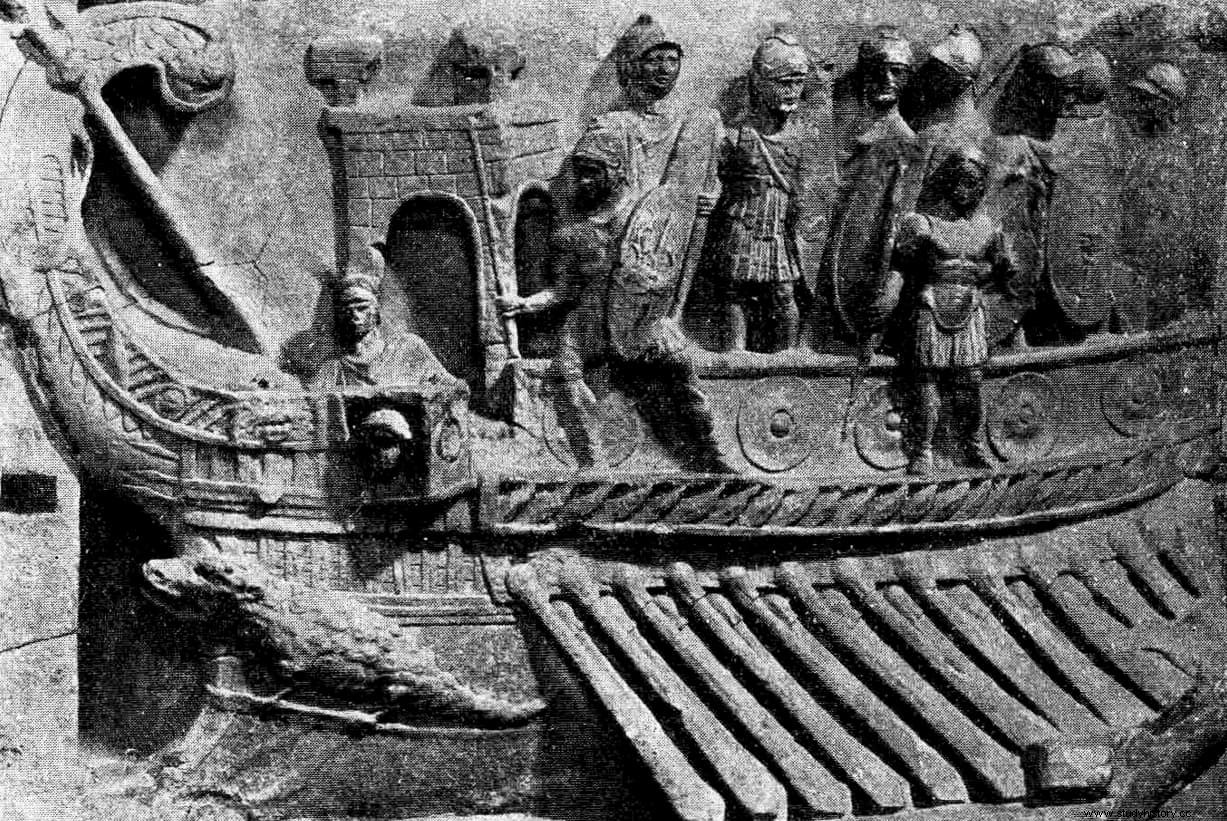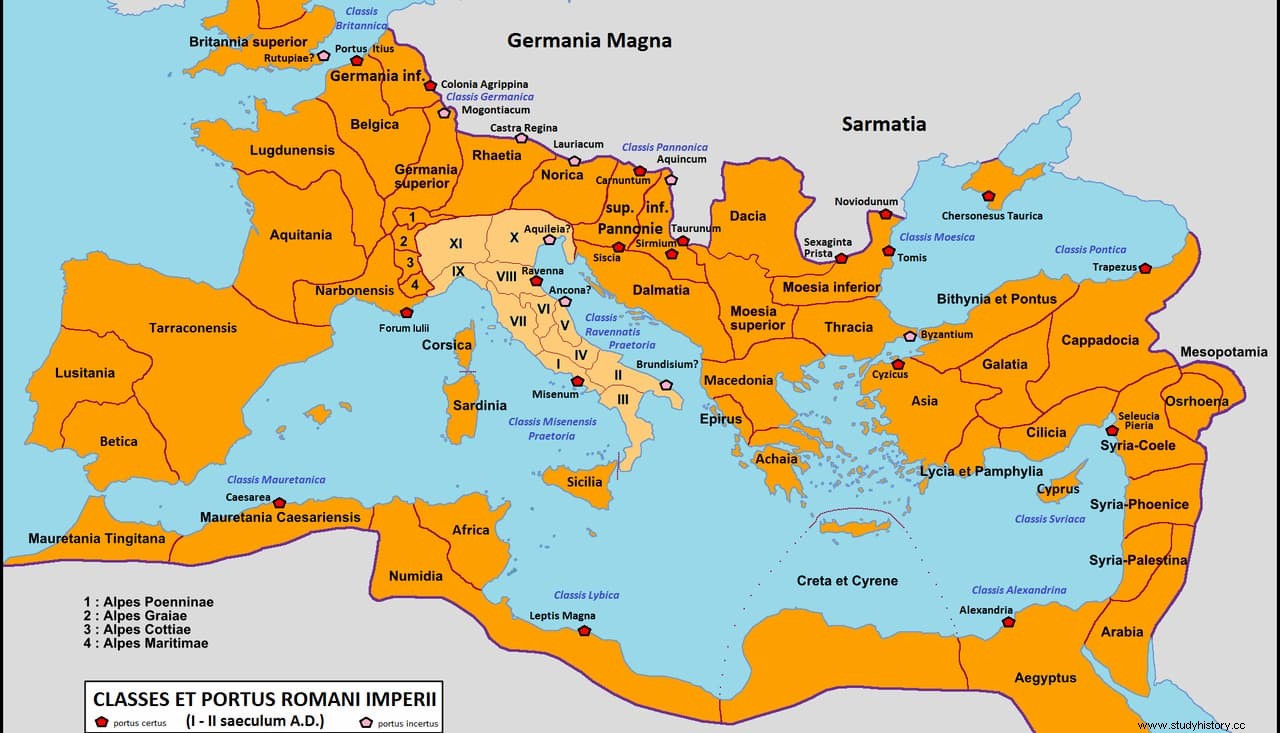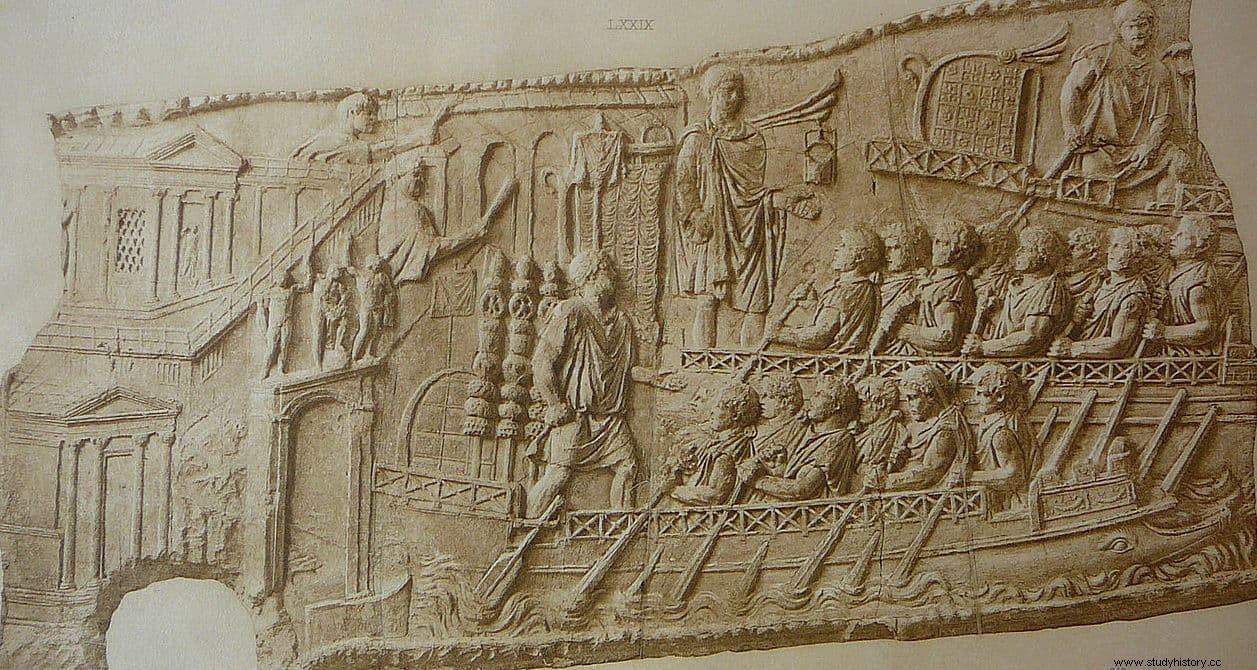It is curious that the weapon that propitiated the hegemony of Rome in the Mediterranean (which in imperial times was known by the name of Roman lake , just as centuries later the Pacific would be called Spanish Lake ), was one as underestimated as the classis (navy, fleet) that, despite being the one that determined the victory over Carthage, was much less prestigious than the legions, to which it was subordinate.
The Romans, in fact, never had much consideration for the navy, even though it was essential to guarantee the supply of grain to the metropolis and transport the troops for their frequent campaigns abroad. Moreover, if we except the original fleet, destined almost exclusively to protect the coast from pirate raids, they did not have a proper one until they collided with Carthage and were clearly inferior at sea. Before, when they needed it, they simply resorted to the naval socii .
The naval socii they were allies or mercenaries, usually from Sicily and Greece, who provided ships and crews. That was insufficient when the First Punic War broke out, so the concepts were changed to build a fleet of one hundred and twenty ships, between triremes and quinqueremes; according to Polibius, taking a shipwrecked Carthaginian ship as a design model, due to the lack of seafaring tradition. That lack, which is like saying inexperience, was also continued with ships and it was necessary to pull on the imagination, introducing a novelty that would give time to balance things.

It was the corvus , a kind of drawbridge with a hook at the end to stick to the deck of the enemy ship and make it easier for the embarked legionnaires to board, thus minimizing the superior Punic naval techniques. As we know, the final victory went to the Romans, who at the end of the last war and already owners of the western Mediterranean, extended their domain to the eastern Mediterranean after also defeating the Illyrians and Pontics. Not without difficulty, since, as there was no longer a power to rival them, they had returned to the system of naval socii recklessly disbanding the fleet, hence it was necessary to form another one again.
With it, and thanks to special powers granted by the Senate, Pompey managed to put an end to piracy, which had become a serious danger to the economy. In addition, a new era of expansion was beginning at the hands of Julius Caesar, to whom the already established classis It came in handy for him to undertake the conquest of Gaul first and Britannia later. The bad thing was that later civil wars broke out and those ships were used to settle who would rule in Rome. The final episode of that fratricidal conflict was starred by Octavio and Marco Antonio, being precisely a battle at sea, that of Actium, which tipped the balance for the first in the year 31 BC
This is how Rome left behind the republican stage to enter the imperial one, which took its first steps with a comprehensive military reform (designed by Marcus Vipsanius Agrippa and financed by the Aerarium militare ), in order to professionalize the army and navy. Here we are not going to analyze it completely, but we are going to succinctly review what affected the army and its members, who became paid volunteers (although slaves were still used when necessary). Initially the main base was located in Ostia, later moving to Forum Iulii (current French Fréjus); later it was decided to divide the navy into two Praetorian fleets that could cover the entire Mare Nostrum .
The first was the Classis Misenensis (later it would be renamed Classis Praetoria Misenensis Pia Vindex ), named for operating from Misenum, in Naples, its mission being to control the western Mediterranean. He had fifty ships and some ten thousand men (if attached legionnaires are included), many recruited in Egypt. Like the legions, the fleets used to intervene in politics and members of the Misenensis they did it in favor of Nero, Septimius Severus or Constantine, for example. Inactivity perks due to lack of enemies.
The other fleet, which was to deal with the eastern Mediterranean, was the Classis Ravennatis (later renamed Classis praetoria Ravennatis Pia Vindex ). That name derives from its base in Ravenna, where there was a port complex with shipyards and capacity for two hundred and fifty ships. However, many sailors resided in Rome, in the Cstra Ravennatium , training often through naumaquias in the waters of the Tiber. As a curiosity, it should be said that the personnel of these fleets were in charge of deploying the velarium (awning) that covered the Flavian Amphitheater, the Colosseum.

Each was commanded by a praefectus classis , extracted from the upper stratum of the equestrian class, with the Misenensis having a higher rank . They were helped by two sub praefeti , in turn aided by various praepositi (officials), the navarchus princeps (directed one or more squadrons of ships), the tribunus classis … Individually, the ships were captained by a trierarch, equivalent to a centurion, under whose command there were sailors, soldiers and oarsmen, all considered milites . The service was longer than on land:twenty-six years, which would be two more from the third century AD. Upon graduation (honesta missio ), they received a payment, citizenship (seafarers used to be peregrini , that is, free but not Roman), a plot of land, and permission to marry (which was prohibited until then).
The classis It was basically made up of triremes (in each of which one hundred and twenty legionnaires embarked, sailors aside), although there were also quinqueremes (with two hundred legionnaires) and liburnas (biremes and monoremes, very light and fast); actually there were more types of ship, including some hexareme, but over time there was a tendency to reduce the size of the ships. They were baptized with names, like today, and they normally operated in spring and summer, staying the rest of the year in their ports; we speak in the plural because fleets used to be subdivided into secondary detachments spread over many places.
These two large Praetorian fleets were joined by smaller provincial ones, sometimes created specifically for specific campaigns. They were the following, in chronological order:Classis Alexandriae, Classis Aquitanica, Classis Germanica, Classis Moesica, Classis Mauretanica, Classis Nova Libica, Classis Britannica, Classis Pannonica, Classis Perinthia, Classis Pontica, Classis Siriaca and Classis Africana Comkodiana Herculea . It also seems that some legions had their own squadrons, such as the Legio XXII Primigenia on the Rhine, the Legio X Fretensis in the Jordan and others in the Danube.
In fact, according to a review Notitia Dignitatum (a description of the administration to which we have already dedicated an article), over time there were many more fleets broken off from the previous ones and during the late imperial period they were destined to control specific areas. Thus, the Classis Pannonica and the Classis Moesica atomized into smaller river squadrons called Classis Histrica , who were left in command of the duces borders and extended through various ports of the Danube.

Similarly, the classis Anderetianorum, Ararica, Barcariorum, Comensis, Fluminis Rodani, Sambrica were assigned to Gaul. and Venetum , while the Britannica and the Germanica They disappeared in the 3rd and 4th centuries respectively. In V the same thing happened with the Africana and the Mauretana , which passed into the hands of the Vandals together with the North African territory. For his part, Constantine would transfer the Classis Ravennatis -by then of diminishing importance- to Constantinople, due to the progressive subsidence of the land in Ravenna (today blinded by the sands and in the interior).
This last fact is revealing and significant, since the Roman army was losing prominence to the same extent that the empire saw its power reduced. In contrast, in the Eastern Roman Empire it was a fundamental force for the maintenance of its hegemony. Its great novelty was the dromon , a three-masted vessel with lateen sails and two rows of oars that is considered the predecessor of the Italian galley. It had a considerable size - up to fifty meters in length - and was accompanied by other ship models, such as the panfil or the kelandia.
The Byzantine fleet, and more specifically the drones, were armed with ballistae and other war machines, just as they had been in previous centuries (the corvus had long since fallen into disuse). But, above all, they had the famous and fearsome Greek fire. It was a mixture of water, gasoline, sulfur, resin, calcium oxide and saltpeter that was fired through a bronze siphon installed in the forecastle, with results similar to those of a large flamethrower.
That army, and especially that of the Karabisianoi (a permanent squad created in the second half of the 7th century), managed to sustain the empire, either fighting, supplying (or both) and sometimes even helping the Western Empire against enemies such as the Vandals, Ostrogoths, Sassanids, Slavs and Arabs , until its final fall in 1453.
